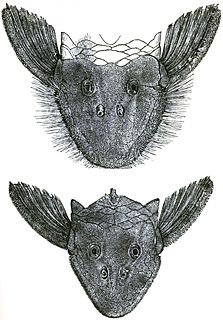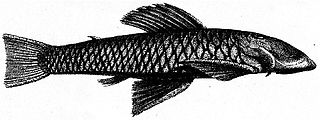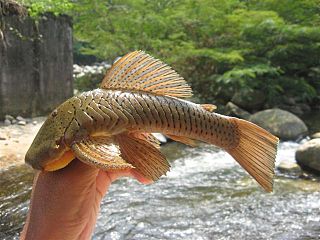
Pseudancistrus is a genus of suckermouth armored catfishes native to South America.

Peckoltia vittata is a species of catfish belonging to the subfamily Hypostominae of the family Loricariidae.
Ancistrus megalostomus is a species of catfish in the family Loricariidae. It is native to South America, where it occurs in the Beni River basin, which is part of the Madeira River drainage in Bolivia. The species reaches 8.3 cm SL and is noted to inhabit high-altitude environments.
Chaetostoma venezuelae is a species of catfish in the family Loricariidae. It is native to South America, where it occurs in the San Juan River basin in Venezuela. The species reaches 7.3 cm SL.

Chaetostoma loborhynchos is a species of catfish in the family Loricariidae. It is native to South America, where it occurs in the Tambo River basin, which is part of the Ucayali River drainage in Peru. The species reaches 14.2 cm SL. It is the type species of the genus Chaetostoma.
Chaetostoma lineopunctatum is a species of catfish in the family Loricariidae. It is native to South America, where it occurs in the basins of the Aguaytía River, the Pachitea River, and the Pisqui River in the Ucayali River drainage in Peru. The species reaches 14.3 cm SL. It appears in the aquarium trade, where it is referred to as the bloodfin bulldog pleco or by its L-number, which is L-276.

Chaetostoma milesi is a species of catfish in the family Loricariidae. It is native to South America, where it occurs in the basins of the Magdalena River and the Apure River. The species reaches 13 cm SL. It appears in the aquarium trade, where it is most frequently referred to as either the bulldog pleco or the rubbernose pleco.
Chaetostoma platyrhynchus is a species of catfish in the family Loricariidae. It is native to South America, where it occurs in the Caquetá River basin in Colombia. The species reaches 9.5 cm in total length. The species is known to be of disputed classification and spelling.
Neblinichthys roraima is a species of catfish in the family Loricariidae. It is native to South America, where it occurs in the Kukenan River basin in the Caroní River drainage in Venezuela. It is known to inhabit creeks devoid of aquatic vegetation with a substrate composed of stones and sand, at an elevation of 1200 to 1400 m. The species reaches 5.1 cm SL.
Peckoltia oligospila is a species of catfish in the family Loricariidae. It is a freshwater fish native to South America, where it occurs in the lower Amazon River basin in Brazil. The species reaches 10.5 cm SL. It appears in the aquarium trade, where it is typically referred to either by its associated L-number, which is L-006, or as the brown-dot peckoltia.
Pseudancistrus asurini is a species of catfish in the family Loricariidae. It is native to South America, where it occurs in the Xingu River basin in the state of Pará in Brazil. The species reaches 19.6 cm SL. Its specific epithet, asurini, refers to the Asurini people, native speakers of the Xingu Asurini language, who inhabit the Xingu basin near Altamira. It was described in 2015 by Gabriel S. C. Silva, Fábio F. Roxo, and Claudio Oliveira alongside the related species Pseudancistrus kayabi from the Tapajós basin.
Pseudancistrus kayabi is a species of catfish in the family Loricariidae. It is native to South America, where it occurs in the Teles Pires River, which is part of the Tapajós basin in the state of Mato Grosso in Brazil. The species reaches 8.8 cm SL. Its specific epithet, kayabi, refers to the Kayabí people who historically inhabited the region surrounding the Teles Pires, Arinos, and Dos Peixes river basins in Mato Grosso. It was described in 2015 by Gabriel S. C. Silva, Fábio F. Roxo, and Claudio Oliveira alongside the related species Pseudancistrus asurini from the Xingu River basin.

Pseudancistrus barbatus, commonly known as the bearded catfish, is a species of catfish in the family Loricariidae. It is native to South America, where it occurs in the basins of the Oyapock, the Mana River, the Maroni, the Suriname River, the Courantyne River, and the Essequibo River. Within its range, the bearded catfish is typically found in rocky, fast-flowing rapids.
Pseudancistrus coquenani is a species of catfish in the family Loricariidae. It is native to South America, where it occurs in the basin of the Cuquenán River, which itself is part of the upper Caroní River drainage in Venezuela. The species reaches 8.1 cm SL, and it is named for the river basin in which it is found.

Pseudancistrus corantijniensis is a species of catfish in the family Loricariidae. It is native to South America, where it occurs in the Courantyne River in Suriname. The species reaches 17.9 cm SL, and it is named for the Courantyne, which is its only known habitat.

Pseudancistrus depressus is a species of catfish in the family Loricariidae. It is a freshwater fish native to South America, where it is known only from Suriname, reportedly occuring in the Coppename River. The species reaches 13 cm in total length.
Pseudancistrus genisetiger is a species of catfish in the family Loricariidae. It is native to South America, where it occurs in the Jaguaribe River basin in Brazil. The species reaches 10.3 cm SL.
Pseudancistrus guentheri is a species of catfish in the family Loricariidae. It is native to South America, where it was initially collected from an unknown locality in Guyana, although it has subsequently been reported from the confluence of the Mazaruni River and the Cuyuni River near the village of Kartabo. The species reaches 12 cm (4.7 in) in length.
Pseudancistrus kwinti is a species of catfish in the family Loricariidae. It is native to South America, where it occurs in the Coppename River in Suriname. The species reaches 9.4 cm (3.7 in) SL. P. kwinti was described in 2010 by Phil Willink of the Field Museum of Natural History, Jan Mol of Anton de Kom University of Suriname, and Barry Chernoff of Wesleyan University on the basis of distinctive morphology and coloration.

Pseudancistrus zawadzkii is a species of catfish in the family Loricariidae. It is native to South America, where it occurs in the Tapajós basin, including the Tracuá River, in Brazil. It is typically found in areas with clear water, rocky outcrops, small waterfalls, and a substrate of rocks and sand. The species reaches 12.9 cm SL.





